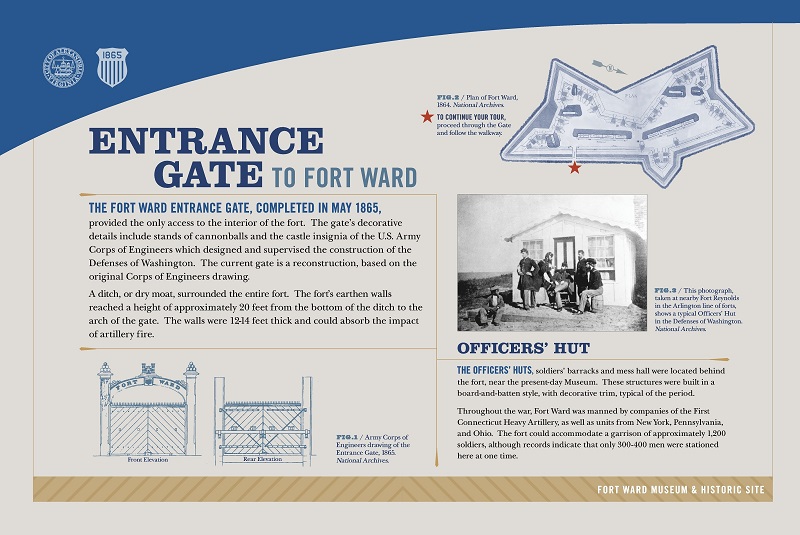
Touring the Fort: Entrance Gate to Fort Ward

Entrance Gate to Fort Ward
The Fort Ward entrance gate, completed in May 1865, provided the only access to the interior of the fort. The gate’s decorative details include stands of cannonballs and the castle insignia of the U.S. Army Corps of Engineers which designed and supervise the construction of the Defenses of Washington. The current gate is a reconstruction, based on the original Corps of Engineers drawing.
A ditch, or dry moat, surrounded the entire fort. The fort’s earthen walls reached a height of approximately 20 feet from the bottom of the ditch to the arch of the gate. The walls were 12-14 feet thick and could absorb the impact of artillery fire.
Officers’ Hut
The Officers’ Huts, soldiers’ barracks and mess hall were located behind the fort, near the present-day Museum. These structures were built in a board-and-batten style, with decorative trim, typical of the period.
Throughout the war, Fort Ward was manned by companies of the First Connecticut Heavy Artillery, as well as units from New York, Pennsylvania, and Ohio. The fort could accommodate a garrison of approximately 1,200 soldiers, although records indicate that only 300-400 men were stationed here at one time.
Fig. 1/ Army Corps of Engineers drawing of the Entrance Gate, 1865. National Archives. (The left image depicts the front elevation of the gate, which is framed by two columns topped with a small stand of cannonballs. The arch extending between the two columns says Fort Ward above a shield with 1865 in the center. The image on the right depicts the rear elevation of the gate, with the doors secured.)
Fig. 2/ Plan of Fort Ward, 1864. National Archives. To continue your tour, proceed through the Gate and follow the walkway. (The image depicts an outline of Fort Ward, with a star marking the entrance gate.)
Fig. 3/ This photograph, taken at nearby Fort Reynolds in the Arlington line of forts, shows a typical Officers’ Hut in the Defenses of Washington, National Archives. (The black and white photograph depicts a one-story building with a chimney on the right side, central door, and a window on each side of the door. A group of five white men in uniform are gathered in front of the building. A black boy is sitting to the left corner of the image in the foreground.)